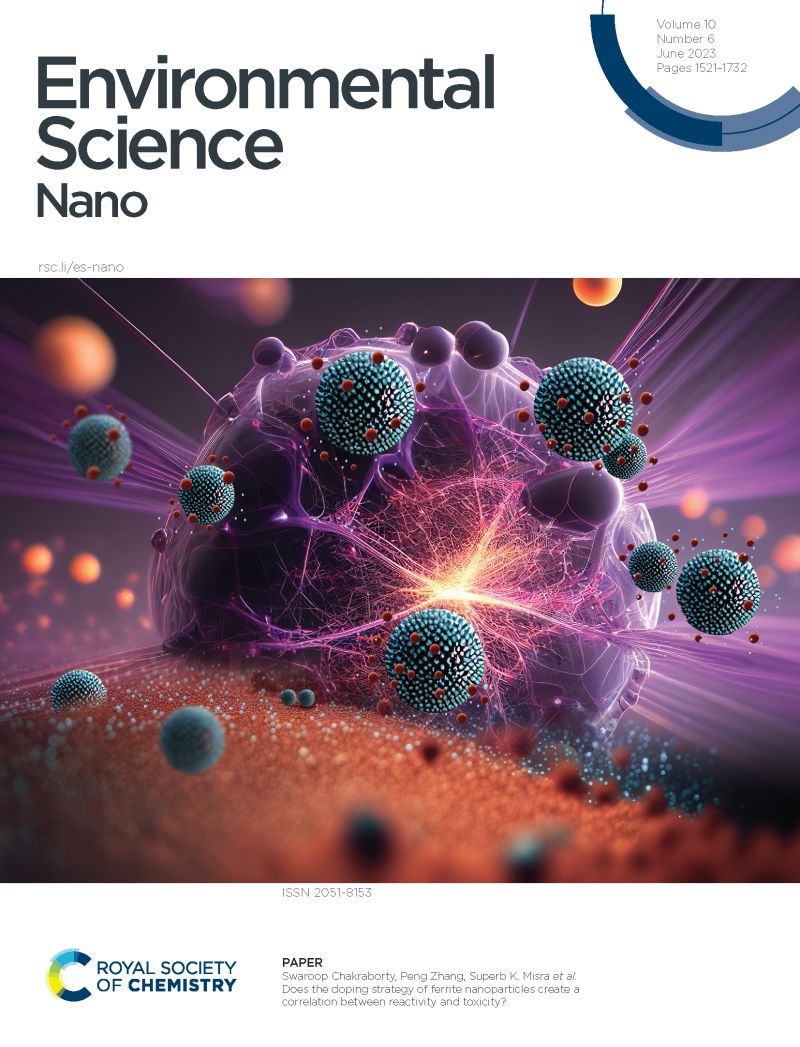MOF-5 Fortified Fiber Optic Plasmonic Absorption-based Pb(II) Ion Sensor for Rapid Water Quality Monitoring
IF 5.8
2区 环境科学与生态学
Q1 CHEMISTRY, MULTIDISCIPLINARY
引用次数: 0
Abstract
Precise detection of heavy metal ions in water is of paramount importance owing to its detrimental effects on human health, especially with spectroscopically silent ions such as lead ions (Pb(II)). This study demonstrates the design and development of a novel portable and field-deployable fiber optic plasmonic absorption-based chemical sensor (PACS) for Pb(II) ion detection using a metal-organic framework (MOF-5) as a highly selective chemoreceptor. MOF-5 was grown in situ over the tannic acid-capped gold nanoparticles (AuNP, 20 nm) of the plasmonic U-bent fiber optic sensor (U-FOS) probes. The Pb(II) ion binding to MOF-5 was detected and quantified as an increase in the plasmonic absorption of the light by AuNP due to significant refractive index changes at the AuNP surface. Besides an excellent selectivity (Pb(II) vs. 11 potential interfering metal ions at 1:50 ppm), these sensors manifest a detection limit down to 0.5 ppb (20 times below the maximum contaminant level of 10 ppb), a wide dynamic range (0.5 ppb to 50 ppm). The sensor was challenged with filtered sewage samples (neat and spiked with 10 ppb) yielded recovery rates within 91% to 105% with respect to the standard ICP-MS analysis. With the notable merits of a facile and scalable probe fabrication process, long shelf-life (at least 12 weeks moisture-free storage), and simpler instrumentation (only with an LED-photodetector pair), the PACS/MOF-5 platform is highly promising for water quality measurements on-site.用于快速水质监测的 MOF-5 强化光纤质子吸收型铅(II)离子传感器
由于水中重金属离子对人体健康的有害影响,尤其是铅离子(Pb(II))等光谱上无声的离子,因此精确检测水中的重金属离子至关重要。本研究利用金属有机框架(MOF-5)作为高选择性化学感受器,设计并开发了一种新型便携式、可现场部署的光纤质子吸收型化学传感器(PACS),用于检测铅(II)离子。MOF-5 是在等离子 U 型弯曲光纤传感器(U-FOS)探针的单宁酸封端金纳米粒子(AuNP,20 nm)上原位生长的。由于 AuNP 表面的折射率发生了显著变化,因此 AuNP 对光的等离子吸收增加,从而检测并量化了与 MOF-5 结合的铅(II)离子。除了出色的选择性(Pb(II) 与 11 种潜在干扰金属离子的比值为 1:50 ppm)外,这些传感器的检测限低至 0.5 ppb(比 10 ppb 的最大污染物水平低 20 倍),动态范围宽(0.5 ppb 至 50 ppm)。与标准的 ICP-MS 分析相比,该传感器对过滤后的污水样本(纯净样本和添加了 10 ppb 的样本)的回收率在 91% 至 105% 之间。PACS/MOF-5 平台具有以下显著优点:探头制造工艺简单、可扩展、保存期长(至少 12 周无湿储存)、仪器更简单(仅使用一对 LED 光电探测器),因此非常适合现场水质测量。
本文章由计算机程序翻译,如有差异,请以英文原文为准。
求助全文
约1分钟内获得全文
求助全文
来源期刊

Environmental Science: Nano
CHEMISTRY, MULTIDISCIPLINARY-ENVIRONMENTAL SCIENCES
CiteScore
12.20
自引率
5.50%
发文量
290
审稿时长
2.1 months
期刊介绍:
Environmental Science: Nano serves as a comprehensive and high-impact peer-reviewed source of information on the design and demonstration of engineered nanomaterials for environment-based applications. It also covers the interactions between engineered, natural, and incidental nanomaterials with biological and environmental systems. This scope includes, but is not limited to, the following topic areas:
Novel nanomaterial-based applications for water, air, soil, food, and energy sustainability
Nanomaterial interactions with biological systems and nanotoxicology
Environmental fate, reactivity, and transformations of nanoscale materials
Nanoscale processes in the environment
Sustainable nanotechnology including rational nanomaterial design, life cycle assessment, risk/benefit analysis
文献相关原料
| 公司名称 | 产品信息 | 采购帮参考价格 |
|---|
 求助内容:
求助内容: 应助结果提醒方式:
应助结果提醒方式:


